Is coding the new literacy? Research by the Consortium for School Networking predicts coding will drive K-12 ed-tech adoption for at least the next two years. Why is it so critical for students to learn basic coding skills at a young age?
1. Technology is everywhere
Children attending K-12 were born into a digital world. Some say that computer literacy is as foundational as reading, writing and math. Teaching code not only prepares students for STEM careers, but gives them a better understanding of machines they will interact with the rest of their lives.
2. Programming exercises multiple areas of the brain
A 2014 study found that when people work with source-code, five brain regions are activated related to language processing, working memory and attention. While more research is needed, this indicates early computational thinking can mold multiple regions of the brain.
3. Diversity in STEM begins in PreK-6
In a study conducted by Bayer, more than 77% of female and underrepresented minority chemists said gender and race disparity in STEM is caused by lack of encouragement to pursue STEM at an early age. By targeting basic STEM skills like coding, schools can facilitate early interest in STEM careers.
4. The world needs computer scientists
While 71 percent of all new jobs in STEM are in computing according to Code.org, only eight percent of STEM graduates studied computer science. Today’s students could fill those gaps in the job market more easily if they learn coding at an early age.
5. Coding is creative
More than just a science, coding enables self-expression. When developing code, students impact the world around them while fostering problem-solving skills. Engagement soars when they see real-world connections to lessons they’re learning.

